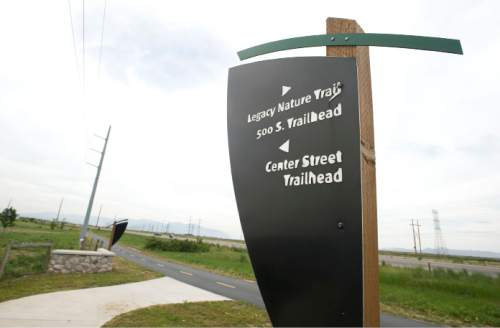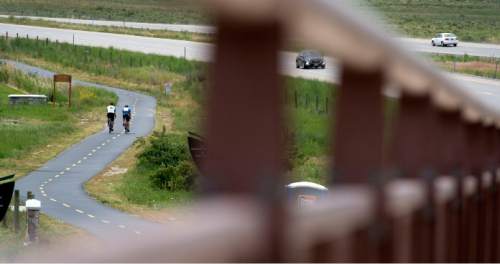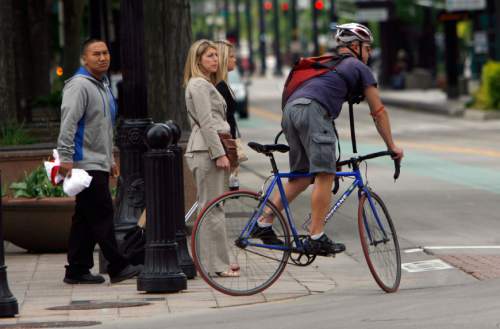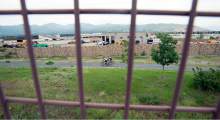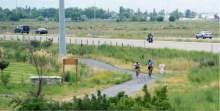This is an archived article that was published on sltrib.com in 2015, and information in the article may be outdated. It is provided only for personal research purposes and may not be reprinted.
Someday in the future, Andrew Gruber says, Wasatch Front residents may look back to the present day as the moment that bicycles became a true form of transportation here — and not just a toy for recreation.
Gruber, executive director of the Wasatch Front Regional Council, says that's because a just-updated, 25-year plan now makes bicycles one of three major pillars of transportation in Utah, along with highways and mass transit.
"I think we are at a turning point in how people think about transportation in our region," he said.
"Many people have ridden bicycles here for years for fun. We have some of the best recreational-biking opportunities in the world right in our backyard," he added. "But now, people are thinking of bicycling as a viable means of commuting to and from work, to school and even to the store or church."
Jory Johner, manager of long-range planning for the council, said, "There are over 1,600 miles of bicycle lanes planned" over the next 25 years — roughly the distance from Salt Lake City to Mexico City.
He notes that while the area's road and transit systems are largely built out, "the bicycle component is still in its infancy. So there are a lot of projects that we need to work on in upcoming years."
Bike lanes are coming in a grid system throughout the area covered by the plan in Salt Lake, Davis, Weber and part of Box Elder counties. Mayors and county commissioners who sit on the council recently approved the once-every-four-years update to transportation plans.
—
Bike trails • Gruber is maybe most excited about creating a dedicated, separate bike lane from Provo to Ogden that parallels Interstate 15 and the FrontRunner commuter train. "How cool is that?" he asked.
That lane would connect a variety of trails including the Jordan River Parkway in Salt Lake County, the Legacy Parkway in Davis County, the Denver and Rio Grande rail trail and the Ogden River trail system.
Another long bike trail of note would stretch between the Oquirrh and Wasatch mountain ranges along 4100/3900 South in Salt Lake County.
Gruber said the Utah Department of Transportation, counties and cities are now regularly looking at adding bike lanes and better pedestrian access any time they widen or improve existing roads or build new projects. "It saves time and money to do those projects together rather than coming back later and trying to add a bike lane."
The new plan is also making some course changes for both mass transit and highways.
For mass transit, it calls for expanding bus service — including more routes and longer service hours — after recently completed expansion of TRAX and FrontRunner lines.
"There is a widely shared view among transportation planners and community members that the focus over the next several years should be on expanding service hours, frequency and coverage," Gruber said.
—
Buses, highways • Several new transit projects also are included in the plans, but they mainly are "bus rapid transit" (BRT) — sort of a TRAX on rubber wheels, where buses use bus-only lanes, tickets are sold by machines, and buses are longer and have more doors for quicker exit and entry.
Among possible BRT lines in the updated regional plan are one from downtown Ogden to Weber State University; from downtown Salt Lake City through Davis County; and, in Salt Lake County, along 5600 West and major east-west routes including 4100/3900 South, 4700 South and extension of an existing BRT line on 3500 South.
On highways, the new plan puts a greater emphasis on maintaining existing roads and finding ways to make them more efficient and carry more traffic — in part because little room exists for new highways in the valleys.
"An example is having the longest continuous carpool lane in the country," Gruber said, including extending current lanes on Interstate 15 from Layton to Riverdale. "It allows us to maximize the use of that interstate."
The new plan moves up the timetable for converting Bangerter Highway in Salt Lake County into more of a true freeway. It calls for earlier conversion of more of its intersections into freeway-like interchanges — similar to what has already happened at 7800 South and is under construction at Redwood Road.
Besides reducing congestion on Bangerter, it will also improve traffic flow on east-west cross streets, Gruber said.
The plan also calls for extending the Mountain View Corridor highway in the short term from 5400 South to State Road 201 in Salt Lake County.
In the long term, that highway would be converted in phases into a freeway and connect to Interstate 80.
Gruber said the new plan is expected to reduce emissions by 53 percent over the 25 years, at the same time the area's population is expected to grow rapidly.
—
Pollution, funding • "That's reflecting that vehicle technology is cleaner, but it also reflects that we are providing more choices to people to carpool or use transit or bike or walk if they want to," he said.
Funding all the projects could be a challenge. Studies earlier projected an $11.3 billion shortfall for priority projects identified in earlier studies and included in the state's 2040 Unified Transportation Plan.
The Legislature this year took some steps to decrease that shortfall, including approving an increase in the state's gasoline tax of 5 cents a gallon beginning next January — with automatic increases to follow.
Lawmakers also authorized counties to hold elections on whether to hike sales tax by a quarter-cent for every $1 in sales. Forty percent of that money would go to UTA in counties where it operates, and the rest would go to cities and counties for road projects. Timing of when such elections may occur is still uncertain.
A copy of the new transportation plan is available online at wfrc.org.
Twitter: @LeeHDavidson



